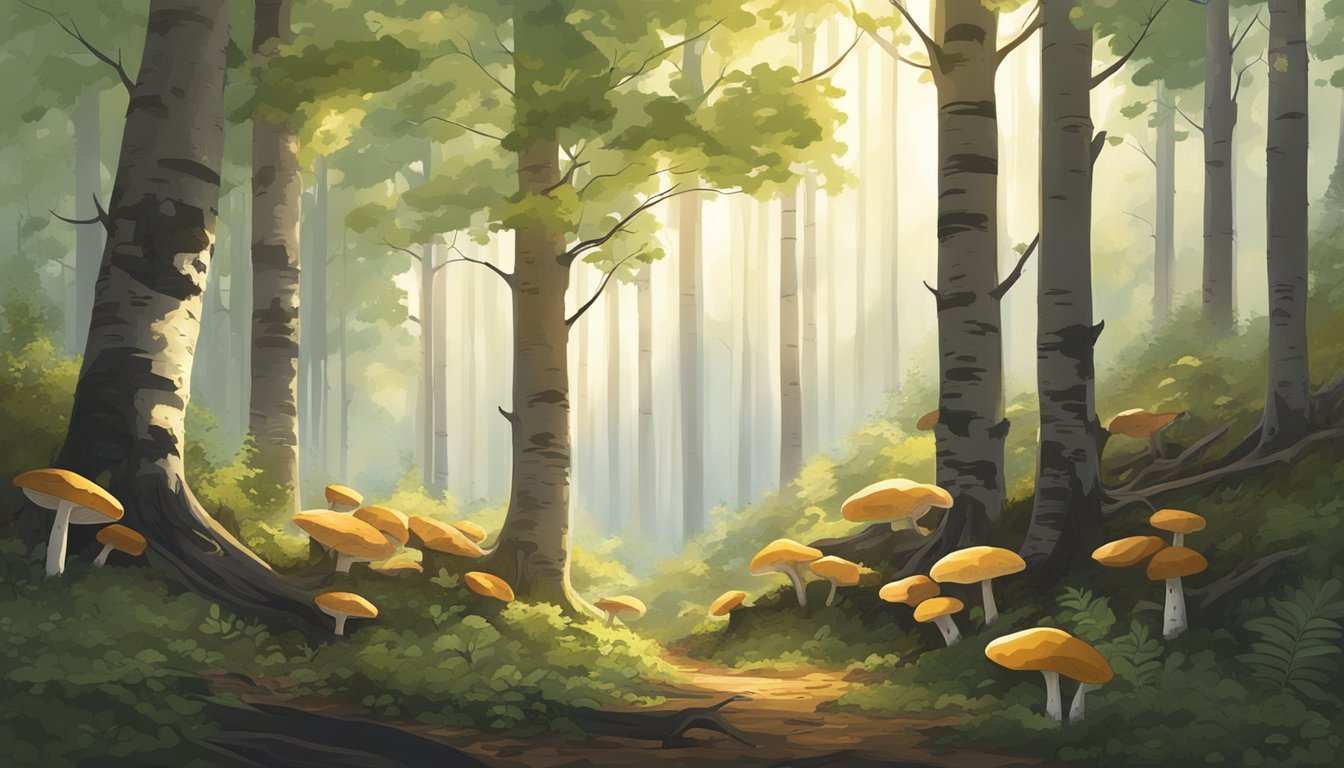Foraging and Harvesting Chaga Mushrooms
A Step-by-Step Guide
This Article is Part of Our Guide on Foraging and Harvesting Wild Mushrooms
Chaga mushrooms (What wine goes well with mushrooms?), scientifically known as Inonotus obliquus, are a type of medicinal fungus that grows predominantly on birch trees in cold climates. Prized for their potential health benefits, these mushrooms have been harvested for centuries, particularly in Northern Europe, Russia, and parts of North America. The exterior of the Chaga mushroom is hard, black, and crusty, while the interior is a rusty yellow-brown color, indicating the presence of the antioxidant pigment melanin.
Foraging for Chaga mushrooms involves a sustainable approach to ensure the longevity of the host tree and the continued availability of this natural resource. Harvesters typically search for Chaga in forested areas during late fall to early spring when the trees are dormant and the fungus is most noticeable. As a slow-growing fungus, Chaga should be collected in moderation, taking care to leave enough behind for regrowth.
Chaga is often sought after for its purported medicinal properties, including its anti-inflammatory and antioxidant effects. Although more research is needed to verify these claims, many people use Chaga as a natural remedy for various health issues. Harvested chunks are typically dried and can be used to make a tea or tincture, with people enjoying the mild, earthy flavor on its own or adding sweeteners and cream for taste.
Chaga Mushrooms are Commonly Found in these US-States
Chaga mushrooms (Inonotus obliquus) are not typically cultivated like button mushrooms. Instead, they grow wild on birch trees in cold climates, primarily in the Northern Hemisphere. In the United States, Chaga mushrooms are most commonly found in the northern states, particularly those with abundant birch forests. Some of the states where Chaga mushrooms are known to grow include:
Chaga mushrooms are also found in other countries with similar climates and birch forests, such as Canada, Russia, and Scandinavian countries.
Understanding Chaga Mushrooms
Inonotus obliquus, commonly known as Chaga mushroom, is a parasitic fungus with a rich history and distinctive appearance that thrives on birch trees. Efficient identification and an awareness of its historical significance are fundamental for those interested in foraging this unique organism.
Biological Profile of Chaga
Scientific Name: Inonotus obliquus
Category: Fungus
Common Names: Chaga, Cinder Conk, Tinder Fungus
Characteristics:
Growth: Primarily on birch trees, manifesting as a sclerotium, which is a mass of mycelium.
Appearance: Hard, blackened, crust-like exterior resembling burnt charcoal; softer, brownish-orange interior.
Chaga does not form a typical fruiting body like mushrooms with caps and stems. Instead, the visible part of Chaga is the dense mycelial mass that protrudes from the host tree.
Historical Use and Cultural Significance
For centuries, Chaga has been utilized in traditional medicine, particularly within Eurasian cultures. It is renowned for its potential health benefits and has been employed as:
A folk remedy for various ailments.
An active ingredient in teas and infusions due to its nutritional compounds.
The historical use of Chaga has been tied to a rich cultural significance, intertwining the mushroom with indigenous practices and ancient wellness traditions.
Identifying Chaga in Nature
When foraging for Chaga, specific signs indicate the presence of this fungus:
Host Tree: Birch (predominant host for optimal growth).
Appearance: Look for the black, charcoal-like exterior against the white bark of birch trees.
Spotting true Chaga requires discernment, as it can be confused with burls or other tree growths. It is typically found in colder climates of the Northern Hemisphere, often on mature birch trees that are either living or in the early stages of decay.
Health Benefits of Chaga Mushrooms
Chaga mushrooms offer a range of health benefits predominantly due to their high nutrient content and antioxidants. Known medicinal properties further enhance their value, especially in the form of teas and extracts, which facilitate their consumption.
Nutrient Content and Antioxidants
Chaga mushrooms are rich in a variety of nutrients and contain powerful antioxidants. They are particularly noted for their high levels of melanin, which contribute to the mushroom's dark color and antioxidant capacity. These antioxidants help in combating oxidative stress and may reduce the risk of chronic diseases.
Antioxidants: Help to protect cells from damage by free radicals.
Melanin: Contributes to protective antioxidant capacity.
Betulinic Acid: Found in the bark of birch trees from which Chaga grows, it has been studied for its potential health effects.
Medicinal Properties
Chaga mushrooms exhibit medicinal properties that contribute to health and well-being. They display anti-inflammatory benefits, which may alleviate conditions associated with inflammation. Additionally, research has suggested antitumor qualities, indicating a potential in cancer prevention and treatment protocols. Chaga is also associated with improving immune function and has been traditionally used in this regard.
Anti-inflammatory: May reduce inflammation and related ailments.
Antitumor: Potential to slow the growth of cancer cells.
Immune Function: Can contribute to enhancing the body's immune response.
Chaga Tea and Extracts
Chaga can be consumed as a tea or in extract form which allows easy intake of its beneficial compounds. Preparing tea involves simmering Chaga to release its active components into the water. Chaga extracts are concentrated forms and may be preferred for ease of use and dosage control.
Tea: Simmered in water to produce a beverage with a coffee-like appearance.
Extracts: Concentrated and versatile for various forms of consumption.
Both forms encourage better cognitive function, stabilization of blood sugar, and improved cholesterol levels. Regular consumption of Chaga in these forms could provide sustained benefits to health, including aids in managing diabetes and supporting cognitive function.
Sustainable Foraging Practices
Sustainable foraging of Chaga mushrooms ensures the preservation of both the fungi and their host birch trees. Understanding how to identify and harvest ethically is crucial to maintain the balance of the ecosystem.
Locating and Identifying the Right Trees
Foragers should assess birch trees, as they are the prime hosts for Chaga mushrooms. Proper mushroom identification is critical — Chaga manifests as a black, crusted growth resembling burnt charcoal. For safe and sustainable foraging, it is essential to confirm the mushroom is indeed Chaga and the tree is alive, ensuring the continued growth and health of both.
Ethical Harvesting Techniques
Harvesting should be done with care to minimize damage. Tools like a sharp knife or a small axe can be used to gently remove the Chaga conk, taking care not to harm the living birch tree. It is recommended to harvest no more than one-quarter of the mushroom to allow for regeneration. Foragers must avoid harvesting from living trees that show signs of disease or instability.
Preventing Overharvesting
Foragers play a vital role in preventing overharvesting. They should only take what they need and leave behind enough Chaga to ensure continued growth and sustainability. It includes being mindful of the size and amount of Chaga taken from any single tree, as well as the frequency of harvesting from the same area. Monitoring areas for signs of overharvesting can help protect these valuable resources for future foraging.
Harvesting Chaga Mushrooms
Harvesting Chaga mushrooms requires precise timing and the right tools to ensure a sustainable yield. The process also must respect the host tree and the ecosystem.
Best Times to Harvest
Traditionally, Chaga mushrooms are harvested during the winter months. The rationale behind this timing is that trees contain less sap during the cold season, which is believed to contribute to a higher concentration of the mushroom's bioactive compounds. Furthermore, in cold climates, Chaga is easier to spot against the bare trees and the frozen environment, which aids foragers in identification.
Tools and Methods
Foragers should equip themselves with:
A sharp knife
A hatchet or a small axe
A chisel
These tools assist in carefully removing the Chaga from the tree without damaging the surrounding bark excessively. The use of a sharp instrument is vital to make clean cuts that facilitate the mushroom's potential regrowth.
Harvesting Procedure
The process of harvesting Chaga mushrooms must be done with care:
Identify mature Chaga, which typically has a burnt charcoal appearance.
Using a hatchet or sharp knife, gently cut into the Chaga, taking care not to penetrate too deeply into the host tree.
Work around the mushroom's edges and pry it off with a chisel.
Leave a portion of the Chaga behind to encourage regrowth.
It is essential not to overharvest, as this may harm the tree and prevent future growth of the Chaga. After harvesting, one should ensure that the Chaga is properly dried and stored for later use.
Processing and Storing Chaga
After foraging, one must properly process and store Chaga to preserve its qualities. This ensures that Chaga can be safely used in teas, tinctures, and other preparations.
Drying and Curing
When processing Chaga, it is essential to first dry and cure the pieces to prevent mold and decay. Foragers should cut the fresh Chaga into 1-2 inch pieces, which allows for consistent drying. These can then be dried in an oven set to 50°C (122°F) overnight. Ensure the Chaga is completely dry before moving to storage, as any moisture can spoil the batch.
Grinding and Storage
Once cured, Chaga can be ground into a fine powder using a coffee grinder or similar device. Some prefer to keep dried chunks for direct use in teas or decoctions. For storage, place the Chaga in airtight containers such as glass jars, and store in a cool, dark place. This helps to maintain the Chaga's potency and prevents degradation of its beneficial compounds.
Preparation for Consumption
Chaga can be prepared for consumption in various ways, the most popular being Chaga tea. To make it, simmer the Chaga in water for at least 20 minutes until the liquid darkens. One tablespoon of Chaga per 4-6 cups of water is a standard ratio, and the Chaga grounds may be reused several times. For those opting for a tincture, high-proof alcohol like Everclear or vodka can be used to extract the compounds by steeping dried Chaga for 6-8 weeks in a dark cupboard before straining.
Consuming Chaga Mushrooms
Chaga mushrooms offer a range of consumption options, from traditional teas to culinary recipes and various supplement forms. Each method leverages chaga's unique earthy flavor and potential health benefits.
Chaga in Tea and Coffee
Chaga tea is one of the most traditional methods for consuming this fungi. Brewing involves a simple process:
Chaga Tea: Simmer 1 tablespoon of chaga per 4-6 cups of water for at least 20 minutes. The liquid should turn a dark, coffee-like color. Chaga can be reused several times until it no longer imparts color or flavor to the water.
For coffee enthusiasts, chaga can be added as a health-boosting adjunct:
Chaga Coffee Additive: Mix ground chaga with coffee grounds and brew as usual to imbue coffee with added nutrients.
Recipes and Culinary Uses
Chaga's culinary versatility extends beyond beverages:
Stews: Its robust flavor complements the hearty nature of stews. Introduce ground chaga during the cooking process to enhance the nutritional profile.
Smoothies: Incorporating a spoonful of chaga powder into smoothies boosts both the flavor and nutrient content.
Supplements and Alternative Forms
Chaga mushrooms are also available in various convenient supplement forms:
Chaga Supplements: Often found in capsule form, these are an effortless way to include chaga in one's daily regimen.
Tinctures: Liquid extracts or tinctures provide a concentrated form of chaga, to be taken in small doses.
Powder: Chaga powder can be mixed with food or drinks for a straightforward nutrition boost.
Environmental and Ecological Considerations
When foraging for Chaga mushrooms, it's imperative to recognize the symbiosis between these fungi and their hosts, predominantly birch trees. In birch forests and other habitats, such as deciduous forests, Chaga mushrooms establish a parasitic relationship with trees, extracting nutrients and, in turn, contributing to the ecosystem.
Chaga's role in the forest:
Parasitic relationship: While they draw sustenance from the host tree, Chaga mushrooms can also support the surrounding ecosystem via their breakdown of the wood and contribution to the nutrient cycle.
Impact of overharvesting:
Overharvesting of Chaga can disrupt this balance, potentially harming the environment by reducing the population of birch trees that play a crucial role in the forest ecology.
Sustainable foraging practices:
Harvesters should remove no more than 25% of the Chaga from a single tree to avoid stressing the host.
A responsible forager always leaves enough Chaga to ensure regrowth, which preserves this natural resource for future generations.
Protection of forest health:
Monitoring the health of birch forests is essential; they should never take Chaga from trees that appear weak or diseased.
Foragers must also respect the existing deciduous forests ecosystem, ensuring that their activities do not introduce unwanted disturbances.
Individuals engaged in harvesting Chaga must be stewards of nature, upholding practices that protect and sustain the forests and their resources. They are the caretakers of a delicate ecological balance, ensuring the continuity of Chaga's availability and the vitality of woodland habitats.
Chaga Mushrooms Around the World
Chaga mushrooms, known scientifically as Inonotus obliquus, flourish predominantly in cold climates of the Northern Hemisphere. This section explores their global distribution and various cultural practices associated with their use.
Geographical Distribution
Chaga mushrooms are commonly found in Russia, Northern Europe, and Canada, where the cold climate supports the growth of birch forests – the natural habitat for Chaga. They also grow in parts of Korea and other regions across the Northern Hemisphere. Here's a brief overview of Chaga presence around the world:
Russia: Vast birch forests offer a prime ecosystem for Chaga, which has been used in traditional medicine for centuries.
Northern Europe: Especially in Scandinavian countries, Chaga is foraged for its purported health benefits.
Canada: Similar to Northern Europe, the cold climate makes it an ideal location for Chaga, where it is often harvested sustainably.
Korea: While not as common, Chaga can be found in certain forested areas of Korea due to the suitable cold climates.
Cultural Practices in Different Regions
Different regions have developed unique cultural associations with Chaga mushrooms:
Russia: Traditional uses of Chaga in Russia often involve brewing it into a tea, believed to have health-enhancing properties.
Canada: Canadians typically forage Chaga sustainably, ensuring no harm to the host tree and taking only a portion of the Chaga conk.
Northern Europe: In Scandinavia, Chaga is sometimes consumed as a coffee substitute or integrated into daily dietary practices for its supposed medicinal qualities.
Each culture respects the Chaga mushroom for its potential health benefits and often incorporates it into natural wellness regimens.
Potential Risks and Side Effects
Health Risks
When incorporating chaga mushrooms into one's diet, it is paramount to consider that although often consumed for their potential health benefits, they may pose certain health risks. It is especially important for individuals with pre-existing medical conditions to consult a healthcare professional prior to consumption. One of the risks involves interaction with medication, particularly for those on anticoagulant or diabetes medication, as chaga mushrooms may amplify the effects of these drugs.
Toxins
Due to chaga mushrooms typically growing on birch trees, they can accumulate betulinic acid, a compound found in the bark of these trees. While this substance can have therapeutic effects, in high amounts, it may be harmful. Persons foraging chaga mushrooms should ensure they do so from unpolluted areas since these fungi can also absorb and concentrate harmful environmental toxins.
Allergic Reactions
Although uncommon, some individuals might experience allergic reactions to chaga mushrooms. These reactions could manifest as skin rashes or respiratory difficulties. First-time consumers should start with small amounts to monitor their body’s response.
Precautions
Consult healthcare providers before starting chaga mushrooms if there are underlying health conditions or if taking other medication.
Source from clean environments to minimize exposure to environmental toxins.
Start with small doses and be observant of the body's reactions to prevent and detect possible allergic reactions.
Modern Research and Future Prospects
Recent scientific research on Inonotus obliquus, commonly known as Chaga mushroom, has illuminated its potential health benefits. Studies have primarily focused on the polysaccharides found in Chaga, which show promise in anticancer application. Clinical studies suggest that these polysaccharides could play a role in inhibiting cancer cells due to their ability to modulate the immune response and potentially induce apoptosis in malignant cells.
Other areas of interest include Chaga's impact on blood sugar regulation, with some research indicating that Chaga may have a stabilizing effect. This has meaningful implications for conditions like diabetes, and further investigation is warranted to determine its clinical efficacy.
In terms of antibacterial capabilities, Chaga exhibits properties that have been observed to combat certain bacterial strains. This aligns with its traditional use but requires more comprehensive clinical trials to fully validate these findings.
The mushroom's anti-aging properties have been noted due to its antioxidant content. However, detailed clinical studies are needed to substantiate the claims and understand the full extent of its benefits.
Despite the optimistic outlook, there is a strong need for further scientific research to move these preliminary findings into concrete evidence that can support clinical recommendations. To maximize its medicinal potential, future prospects in Chaga research may involve:
Expanded Clinical Studies: Rigorously designed trials to test efficacy and safety in humans.
Sustainability: Monitoring the environmental impact of increased harvesting.
Standardization: Developing standards for dosage and preparation methods.
The ongoing study of Chaga mushrooms could contribute significantly to natural health products, provided that upcoming research substantiates the promising findings observed thus far.
Chaga Mushroom FAQs
In this section, readers will find concise answers to common inquiries and clarifications on prevalent misunderstandings concerning Chaga mushrooms.
Common Questions Answered
What are Chaga mushrooms? Chaga mushrooms, or Inonotus obliquus, are a type of fungus that predominantly grows on birch trees. They form a hard, blackened mass on the outside, with a reddish-brown interior.
How do you forage for Chaga mushrooms? Foragers should look for Chaga mushrooms on living birch trees, identifying them by their distinct charred appearance. Harvesting requires a sharp tool, and only a portion of the conk should be removed to allow regeneration.
Can I reuse Chaga mushroom grounds? Yes. After making Chaga tea, the grounds can be reused 2 or 3 times. Ensure the water remains opaque, similar to black coffee, which indicates the presence of beneficial compounds.
Myths vs. Facts
Myth: Harvesting Chaga kills the host tree. Fact: If harvested responsibly, leaving at least 25% of the sclerotium attached, the tree can continue to live despite being parasitized.
Myth: Chaga mushrooms have stems and caps like other mushrooms. Fact: Chaga grows into a dense mass called a conk without a distinct stem or cap, and it's commonly found on birch trees.
Conclusion
Foragers seeking Chaga mushrooms can take pride in having learned the methods to sustainably harvest and utilize this distinctive fungus. They should remember to simmer the Chaga for at least 20 minutes to prepare tea and may reuse the grounds multiple times. Making tinctures requires patience, as the Chaga must steep in alcohol for several weeks.
One should be mindful of the environmental impact of harvesting. Leaving at least 25% of the Chaga on the tree allows for regeneration, ensuring the ecological integrity of the forest and the health of the tree.
Drying Chaga properly is crucial; one must spread out the chunks in a cool, dry place for roughly a month to prevent mold. This meticulous approach secures the mushroom's benefits and endorses a respectful relationship with nature.
Adherents of ethical foraging must:
Rinse Chaga to remove debris.
Break into manageable pieces for drying.
Follow the 'black coffee' appearance for tea readiness.
Use high-proof alcohol for tinctures, steeping in a dark place.
Through these practices, foragers not only foster the continuity of Chaga mushrooms for future generations but also ensure the highest quality of their harvest.
References and Resources
When foraging and harvesting Chaga mushrooms, it is essential to rely on reputable sources and scientific references. They provide guidelines for identification, ethical harvesting practices, and potential uses of Chaga mushrooms. Below is a curated list of resources that may assist individuals in their foraging endeavors:
Books and Guides:
"The Forager's Harvest: A Guide to Identifying, Harvesting, and Preparing Edible Wild Plants," by Samuel Thayer, covers the fundamentals of foraging, including Chaga mushrooms.
Scientific References:
Research articles found on PubMed or Google Scholar can offer in-depth information on the pharmacological properties of Chaga mushrooms.
Websites:
MorningChores: Provides practical tips on how to find, harvest, and process Chaga.
Comprehensive Guide to Harvesting Chaga: Outlines sustainable harvesting methods.
Organizations:
Local mycological societies often hold workshops and forays which can be invaluable for learning about sustainable foraging.
Online Resources
Resource Type Description Availability Online Forums Discussions on foraging, with experienced foragers offering tips Accessible 24/7 Educational Videos Visual guides on identifying and harvesting Chaga Various online platforms Scholarly Journals Peer-reviewed studies on Chaga benefits and uses Libraries/Online
For those interested in preparing Chaga, recipes and methods can also be found through a variety of cooking and herbalism websites. Whether one is making Chaga tea or a tincture, proper instructions are vital. For further reading, websites such as those mentioned above, or blogs dedicated to mycology and foraging can be excellent sources of information.








